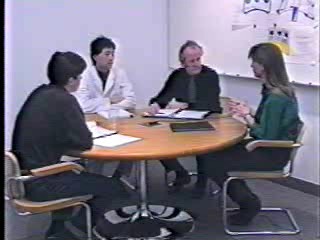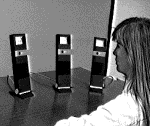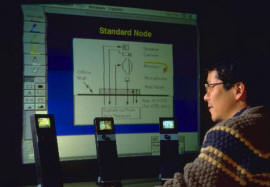I often don’t live where I work. So, if I want to work face-to-face with my colleagues, I either have to travel a lot, or videoconference. After doing a fair bit of it, I came to not like video conferencing very much. (Actually, I didn’t like it even at the start. It just took a while until I got frustrated enough that I started doing something about it.) First, I wanted to get the image of the remote people off of my computer screen. It already has too much stuff on it, no matter how big it grows. Second, I wanted to be able to do things in video conferences that I did in live meetings, such as whisper in someone’s ear, or break off into a brief side conversation, yet still be able to keep track of what was going on. And, I wanted people to know who or what I was looking at, just as I wanted to know the same about them. Such things are the underpinnings of our face-to-face social interactions, and they are typically awkward (at best) or absent (at worst) in electronic communication.
So what we did is build little video “surrogates” that could be occupied by the remote people. Each little unit had a camera, speaker and monitor. The speaker, then, was not a “loudspeaker” but a surrogate mouth. The camera was not a :video camera” but a surrogate eye, and the eye and the mouth were attached to the “body” (Monitor) and together they occupied their own unique physical space. For a four-way round-the-table conversation, think of three little towers on your desk which together take up less space than a telephone. If everyone is set up the same way, you can each be in different places, but still have your own “seat” in a 4-person “round table, with someone across the table from you, to your left, and to your right. Because each person’s voice comes from their own unique location, you can exploit what is known as the “cocktail party effect” and hear them all, but attend to the one that you want. Plus, everyone knows who is looking at who. Why? Because the whole thing was designed to exploit the very same skills that you had built up from a life time of living in the everyday world. And, because the units were so small, there was still room on your desk for your other work.
And, if you build in the same “intelligence” in these devices that turns on the faucets in public washrooms, they even have the potential to give you a private audio link if and when you lean over close to one of them and speak.
When we built these in the early ‘90s, they worked, but they were not technically or economically practical. But times are changing. And, the interesting thing is that it may turn out that as such things appear, we learn that more of the right technology may result in less intrusion, and interactions that far more approximate, and emulate how we normally interact. More appropriate design can lead to more transparency, rather than more things to frustrate.
For more information see (Note the videos):
-
Buxton, W. (in press). Space-Function Integration and Ubiquitous Media.
-
Buxton, W. (1995). Ubiquitous Media and the Active Office . Published in Japanese (only) as, Buxton, W. (1995). Ubiquitous Video, Nikkei Electronics, 3.27 (no. 632), 187-195.
-
Buxton, W., Sellen, A. & Sheasby, M. (1997). Interfaces for multiparty videoconferencing. In K. Finn, A. Sellen & S. Wilber (Eds.). Video Mediated Communication. Hillsdale, N.J.: Erlbaum, 385-400. [video]
-
Sellen, A., Buxton, W. & Arnott, J. (1992).Using spatial cues to improve videoconferencing. Proceedings of CHI '92, 651-652. Videotape in CHI '92 Video Proceedings. [video]


